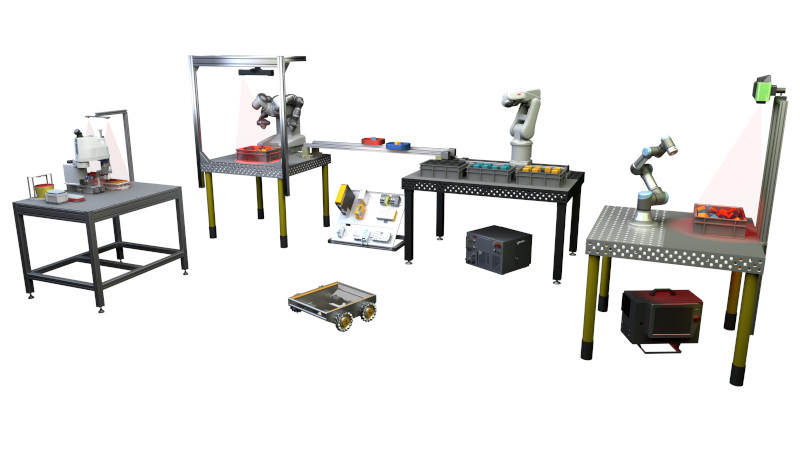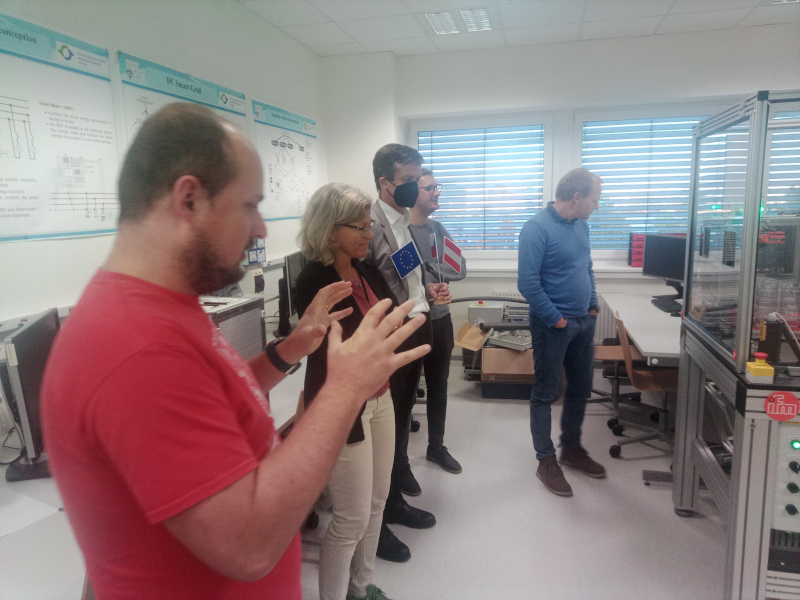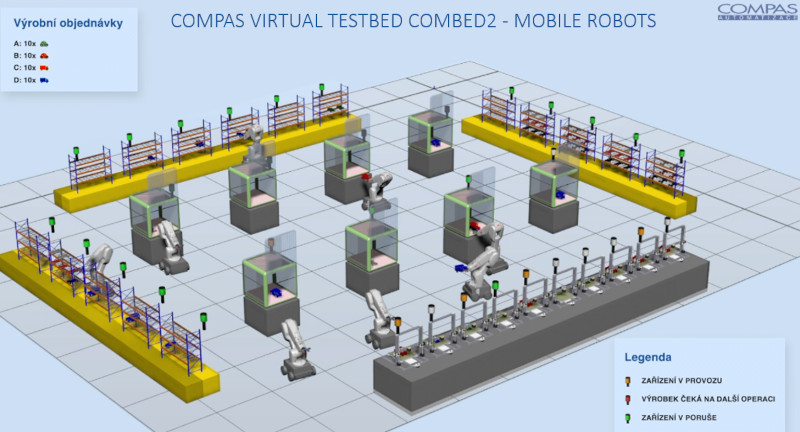The representatives of individual testbeds met at Brno University of Technology on October 20 and 21. The objective of the meeting was to discuss teaching methods and issues, make a tour of the laboratories of Brno testbeds, present research and development projects, and look for possible areas of cooperation. The representatives of all member testbeds participated in the meeting (with the exception of Dr. Aburaia from FH Technikum Wien who could not participate due to a positive Covid test.)
The meeting on Thursday started with a discussion about the methods and issues of teaching technical subjects. Almost all participants agreed that they faced a considerably lower quality of students, mainly after the COVID-19 pandemic and related lockdowns. A loss of motivation and interest in studies were identified as the main causes. The lower level of knowledge is only a consequence. To address this issue, the motivation of students and their interest in their field need to be restored. The concept of open laboratories and student hubs may be a possible way to address this. This principle already exists at many universities (the representatives of Brno and Jihlava testbeds saw this at the International Burch University in Sarajevo at this year's PDES 2022 conference) and could provide the desired results in motivating students while not necessarily being too costly. Open student laboratories do not require the top-quality equipment which is necessary for standard research. In the discussion, it was also mentioned that the pandemic and related distance education did not only have negative impact.
Education at Czech and Austrian technical universities is similar to a large extent. Teachers and students at these universities also encounter similar topics and issues. A fundamental aspect of Industry 4.0 is that it is not a new individual technical field, but it rather consists in an interconnection and combination of existing technologies. The interconnection of fields such as sensorics, robotics, industrial control, programming, and virtual reality creates a new value-added. This means that at least a general knowledge of these constituent technologies is necessary to properly understand the sense of Industry 4.0. However, we increasingly see at both Czech and Austrian universities that students lack the fundamental knowledge in individual fields, which makes them unable to properly understand and use the system. Thus, we can often see them use excessively robust tools to solve basic problems because they cannot imagine how simple can a solution be on a lower, adequate level. However, gaining necessary information and, above all, a broader scope of knowledge in a wide range of technologies associated with Industry 4.0 often goes beyond the possibilities of a regular student and the study programme. Within the discussion about possible ways to address this issue, Dr. Erol from the university in Neustadt shared a very interesting suggestion: go beyond the traditional teaching model of lectures and seminars. In a wide range of (not only) technical subjects such as programming, lectures turn out to be a very inefficient method of teaching in comparison to hands-on seminars. Abandoning the traditional model of lectures and replacing them with practical seminars would make the teaching of many subjects more efficient and would save time not only for students, but also for professors and other academic staff members.
The discussion could of course not avoid Covid and its impact on education. The pandemic naturally affected education very deeply. It will take many years to fully recover from its effects. Students' loss of motivation and interest in learning and in their personal professional growth were identified as the main effects of the pandemic-related lockdowns. A decrease in students’ knowledge and orientation in the fields is nothing but a consequence of this primary cause. This is why academic staff members should mainly focus on enhancing students' motivation, making studies more attractive and stimulating the interest of students in the fields. At technical universities, creating open laboratories or student hubs as places for students to do their own development might help. In order to reach the desired goal: stimulate students' interest in the field, these steps do not have to be necessarily very costly; the equipment of such laboratories does not have to be as top-quality as the equipment needed for research. However, lockdowns did not only have negative effects. This period brought us benefits such as people getting used to online technologies and online classes, and a better quality of teaching materials. Better cooperation of students in solving assigned tasks also counts among major changes the pandemic brought about. It became usual for students to make their own online streams where they communicated without teachers along with the standard streams with teachers. Students then usually found answers to teachers' questions collectively rather than individually. Online tools that started to be used in classes during the pandemic will surely continue to be used in some form. There will be a growing demand for online streaming, the recording of lectures, and electronic examination methods. These methods clearly help both students and academic staff save time. However, the physical presence or unique nature of specialized equipment only available in university laboratories is what stimulates students' motivation. This is why it would be very unwise to see online teaching as a tool that can replace the existing forms of teaching on a mass scale in a rash attempt to take a modern approach.
Participants also went on a tour of laboratories of Brno testbeds. The laboratory of the Institute of Production Machines, Systems and Robotics boasts a large industrial installation of a robotic machining centre. The testbed staff have developed a digital twin of this system based on Unity system. The twin is the virtual representation of the real tool and is mainly used to make machining parameters more accurate. To operate such a large system is fairly challenging. This is one of the reasons why the laboratory also is equipped with a purely educational robotic unit which is used in regular automation-related seminars.
Next, the participants visited the laboratories of the Institute of Automation and Computer Science. These laboratories mainly focus on the cooperation of smaller robots using visual data from 3D cameras. As the next exciting and practical application, the participants saw a robotic stand for the assessment of COVID test samples developed by The Institute of Automation and Computer Science in cooperation with The University Hospital Brno.

The last place the participants visited was the laboratory of the Department of Control and Instrumentation. An automated beverage production line using the principles of decentralised control of individual parts of the line and implementing AAS principles is the institute's showpiece.

Discussion about current research and the focus of the testbeds showed that even though each university naturally followed its own path, many of their interests were very close. Digital twins turned out to be a major shared area, even though they are approached differently by individual centres. Testbeds at the Faculty of Electrical Engineering and Communication in Brno, the College of Polytechnics Jihlava as well as Compas, spol. s r.o. see digital twins as tools for the control and optimization of the entire production process and intend to develop a standardised form of twin using AAS. The Department of Control and Instrumentation and Compas, spol. s r.o. have already worked on a joint project to develop a framework for an automated generation of digital twins using AAS. Results of the projects were used to design a virtual production line with a decentralized control by COMES system (https://www.compas.cz/en/industry-4-0/smart-manufacturing-management-uses-aas/).

This idea is in line with the concept of custom manufacturing by customisation of a standard product presented by the colleagues from Wiener Neustadt University. With tens or hundreds of parameters of a standard product line, there are thousands of variations of end solutions for clients. A fully automated control of the sequence of individual production operations is absolutely necessary for an efficient production of customized pieces able to compete with serial production in terms of costs and delivery time.
By contrast, testbeds at the Faculty of Mechanical Engineering and colleagues from Johannes Kepler University Linz see digital twin as a virtual representation of a particular object which can be used to model its behaviour and states of the production process. The twin can be used to observe and predict the physical parameters of materials and to control and make machining in a machining centre more precise. Virtual or augmented reality are the main technologies of this kind of twin. The virtual twin of the robotic machining unit at the Institute of Production Machines, Systems and Robotics at FME, Brno University of Technology is a very successful example of this use.
Even though the two approaches focus on different levels of production process control, they share the need for the collection and processing of a considerable amount of data, use of fast, standardised communication interfaces, and high computing performance requirements. As a HW platform, both types of twins absolutely require an independent, sufficiently powerful PC separated from the (often real-time) control system and able to communicate with the system with a sufficient flexibility. A standardised protocol such as MQTT or OCP UA is an ideal tool for this communication.